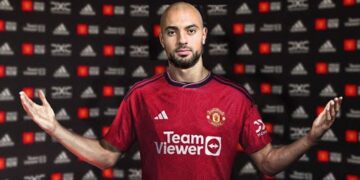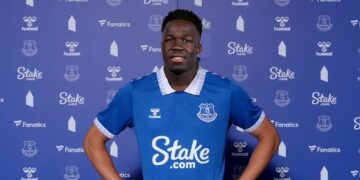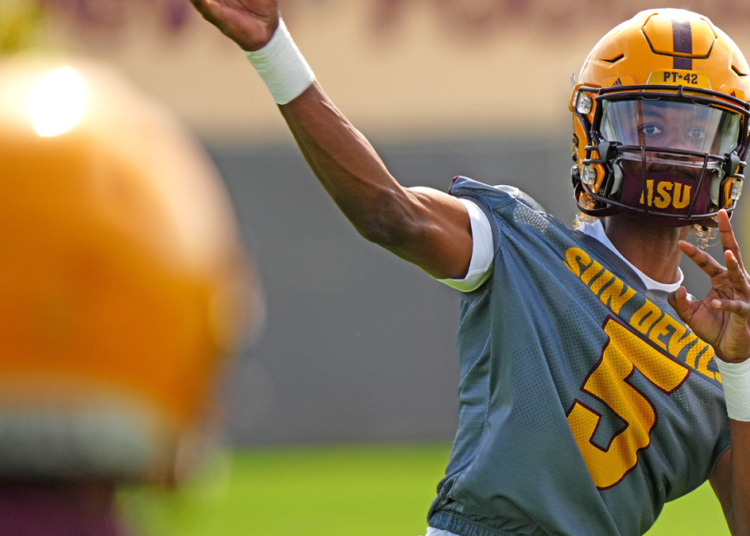TEMPE, Ariz. — The $13 Million Quarterback tried to blend in Saturday. No problem there. Even Jaden Rashada agreed he didn’t nearly live up to the hype during Arizona State’s spring game.
“I didn’t do too well today,” the Sun Devils’ quarterback told CBS Sports after being sacked several times and throwing an interception.
Rashada’s game is not the entire story, though. There was an ancillary reason he was surrounded by autograph seekers after the scrimmage. Like it or not, Rashada might as well be the face of name, image and likeness now 22 months into its existence.
Those aforementioned eight figures was reportedly the offer Rashada received by a now-defunct Florida collective for his NIL services. It remains the largest rumored offer connected to a high school football prospect in the NIL era. Heck, likely for any prospect in any college sport in any era.
That NIL deal — of whatever actual value — famously, publicly and embarrassingly broke down. Rashada — a valued four-star prospect from California — was ultimately released from his Florida scholarship and signed with Arizona State.
“I never thought I could handle something like that,” Rashada said. “You go through it. It’s part of it. It’s part of life. You can’t really control what’s in front of you.”
A comfortable landing spot was also a familiar one. Arizona State, long a mediocre Pac-12 program, is the alma mater of Jaden’s father Harlan, who played defensive back for the Sun Devils from 1992-94.
“I feel incredibly bad for the fact — thank God his dad played football at Arizona State, so he had a place to go,” NCAA president Charlie Baker told CBS Sports. “I really hope that kid has an amazing college career, and at some point, has the ability to get the kind of [NIL] agreement his ability as a student athlete would entitle him to.”
Now, the challenge becomes ensuring Rashada’s game on the field, not his NIL experience, is the first sentence on his Wikipedia page.
“That’s a great example of what the so-called ‘Wild West’ looks like and what happened — what can happen,” Baker said.
What can happen continues to be fought out on the recruiting trail, football fields, courtrooms and even Capitol Hill. What is happening is what NIL has become almost two years months into its implementation by the NCAA: the ultimate argument over whether compensation liberates the athlete or pollutes the system.
On the field, the games themselves haven’t changed. In fact, there has been a refreshing emergence of underdogs in the last two years in the College Football Playoff and NCAA Tournament.
Off the field, athletes have long been compensated in different forms. It seems now we’re merely talking about how many zeroes are in the checks.
Will a system over a century old keep from breaking while major-college sports decides what it wants to be, or will the NCAA dawdle and let the courts decide its future?
For some, NIL has been a runaway success, acknowledgement that athletes should be able to profit off their names, images and likenesses — just like normal students. An LSU gymnast (Olivia Dunne) has become a superstar influencer. Miami guard Nijel Pack signed a two-year NIL deal worth $800,000. Who among the Hurricanes faithful would argue against the return on investment? Miami went to its first-ever Final Four earlier this month.
Collectives were established out of thin air in the wake of the NCAA’s “interim policy,” which was essentially little policy at all to regulate NIL. Those collectives sprung up in 2021 to collect booster donations and distribute NIL money to athletes.
Among the worst abuses has been those collectives running much of the recruiting process and essentially buying players. Rashada decommitted from Miami during his recruitment ostensibly because he wanted to attend Florida and the Gator Collective was able to offer more.
The quarterback said he visited about 15 schools after his NLI release. Rashada’s marketing agent, Jackson Zager, told CBS Sports “four or five” schools offered the player seven figures following his Florida departure.
The decision came down to TCU and ASU with no NIL involved.
“I felt bad. There’s not many options out there,” Zager said. “Everybody’s committed [at that point — after the early signing period]. Everyone is kind of locked up at the big schools. He didn’t have his pick like he would have during recruiting season.”
As if to highlight the situation in real time, Rashada was approached following Arizona State’s spring game by an individual identifying himself as Kevin White, the latter of whom told CBS Sports he works for Bolt Laundry, a Virginia-based company that provides laundry service through an app. There was nothing wrong with the brief encounter, but it was clear NIL opportunities never cease invading a top player’s life.
“I’m just bothered by the fact that families have no idea when someone says to them, ‘This is what your son or daughter is — quote, unquote — worth,” Baker explained. “They have to rely on people who may or may not have their best interests at heart. I don’t want to limit what anybody gets, but I definitely want them to know what they’re getting.”
Zager himself is a sign of the times. Only a sophomore at SMU, he established JTM Sports amid the NIL landscape. He and his partner have about 25 clients. On some level, he agrees with Baker regarding the victimization of players.
“How could you not feel badly for the kid?” Zager said of Rashada. “He’s being called a greedy asshole, son of a — whatever it is, excuse my language. None of that is true. If anyone knows Jaden Rashada, he’s one of the best people I’ve ever met.
“If you want to point the finger at someone, point it at us … or point it at Florida or point it at the parties that were involved in negotiating that deal.”
The NIL argument has evolved. It is not so much about money anymore but how much money. As a result, arguing fair market value is becoming a slippery slope. You’re worth what someone will pay you as long as there is a service to be performed. Raising that quid-pro-quo question also starts to tread into hypocrisy. What college coach is worth $10 million when the players aren’t compensated?
“It’s better this way than having someone handed a bag with $30,000 in it,” Zager said of NIL benefits. “At least it’s kind of out in the open. It can be discussed. It’s going to happen regardless.”
There is a zero-sum game looming: win or lose for the NCAA in NIL. The players already achieved the ability to earn some level of compensation and transfer freedom. Those rights aren’t going way. The question is whether the NCAA can retain any control in terms of the financial management of the product.
As one administrator put it, Baker is the NCAA’s last, best hope at reigning in NIL excesses. The 66-year-old former Massachusetts governor has put forth a credible, good-faith effort to do just that since taking office March 1.
Unlike predecessor Mark Emmert, Baker has strategically engaged legislators in Washington D.C. Baker’s asks of Congress include consumer protections in cases like that of Rashada. Agent certification and a registry for uniform standard contracts are also on his list.
But the biggest ask of Congress is a national preemption that would override any differences in state NIL laws. Dozens of states have adopted dozens of different NIL standards. Some states have done nothing at all.
Achieving NIL regulation with one overarching federal law in this politically divisive age continues to appear unlikely. At least five different NIL bills have been introduced with none finding much traction.
Why, Baker was asked, would a Louisiana senator be inclined to vote for a federal law that hurts LSU’s ability to win? Louisiana is among the states that allows NIL benefits for high schoolers.
“Even the folks in Louisiana don’t want to be in a position where — because the laws in Oklahoma are different — [those in Oklahoma] can start poaching student-athletes who play for McNeese State or LSU or Louisiana-Lafayette or Tulane,” Baker said.
“I totally understand from Baker’s standpoint and some of the membership’s standpoint why he’s asked for [NIL regulation]. It doesn’t hurt to ask,” said Mit Winter, a Kansas City-based sports law attorney that assists in NIL deals. “I just can’t see it happening. An antitrust exemption, gosh. Especially so soon after they’ve been found 9-0 by the Supreme Court to be violating antitrust law.”
Winter was referring to the 2021 Alston v. NCAA case that opened the door for NIL. The Supreme Court unanimously found against the NCAA in a case where the plaintiffs sought a narrow set of education-based benefits for athletes. The NCAA decided to take that argument to the Supreme Court. It may have been the association’s undoing.
Since that decision, the NCAA has never had a better advocate or a better chance. Baker is that last, best chance for the association to retain some of its tradition (read: power).
“One [athletic director], she basically said, ‘Look, the only thing that’s true about NIL is everybody lies.'” Baker asserted.
That conclusion doesn’t consider athletes who give their NIL monies to charity. It doesn’t recognize NIL money being the deciding factor in keeping kids in school if they are marginal NFL Draft talents.
North Carolina basketball center Armando Bacot credited NIL income for making easier his decision to return to school next season. Iowa women’s basketball star Caitlin Clark has been a tremendous inspiration. Clark has become a marketing phenomenon landing NIL deals with Topps, H&R Block, Buick and Bose.
“I wonder how many of those things will get done [by players] who weren’t Caitlin Clark,” Baker countered, “who no one will know about unless there is a way to register these [deals] and make them publicly available.”
Should the NCAA or the federal government even be deciding fair market value? Opendorse CEO Blake Lawrence, an NIL industry leader, has assembled a book he can sell to clients that lays out the average NIL income for football players by position.
That might be a starting point in terms of establishing market value. NIL market forces are emerging, though somewhat crudely. Last year, Ohio State coach Ryan Day set the market value of top quarterbacks in the NIL era at $2 million. He suggested it would take $13 million in NIL deals to keep his roster together.
Perhaps outlandish numbers, but at least a ceiling had been set in the mind of one of the nation’s best coaches.
Several administrators who spoke with CBS Sports were resigned to some sort collective bargaining process with players, even if they did not agree with the way the landscape has changed. At least with collective bargaining there would be cost certainty and expectations about player retention.
“I think we have to be thinking around those lines [partnering with players with NIL],” Big East commissioner Val Ackerman told CBS Sports last year before Baker took office. “Maybe someone’s quietly working on this in a back room, but that’s not a help to us. This should be a more transparent process. This should be a very public call to action on this. And I think it should be led by the national office.”
If his efforts on Capitol Hill don’t succeed, Baker told CBS Sports the NCAA is prepared to soldier on “through the governing structure we have.”
“If Congress doesn’t get this done, we believe we can do a bunch of these things,” said Baker, who did not elaborate further.
For now, we are left with the system’s floor straining under the weight of change. Last month’s New York Times op-ed by Notre Dame AD Jack Swarbrick and president Fr. John Jenkins was its own call to action.
The powerful pair agree with much of what Baker proposes. They also might be too idealistic at this late date.
Here in the desert, we are left with a humbled freshman quarterback just starting his collegiate career, a poster child for NIL — whatever NIL is these days.
“I want to accomplish everything I want to in college football,” Rashada said. “And that’ll come. Just remember me saying this, ‘That’ll come.’ I don’t know when, but that’s up to God.”
Read the full article here


























